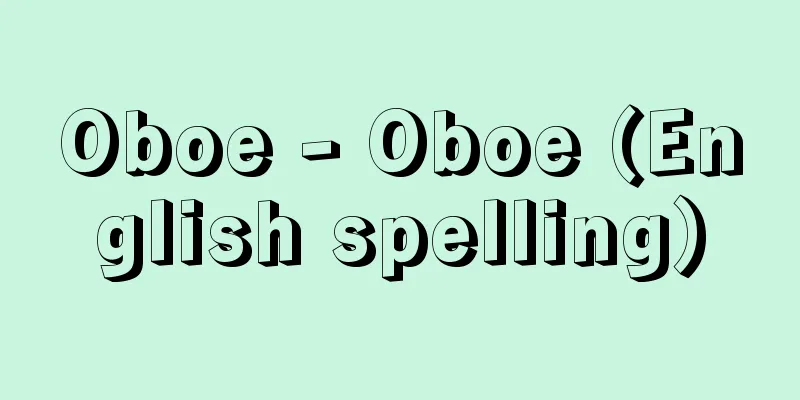Pancreas

|
The pancreas is a digestive gland that belongs to the digestive system and is one of the two major digestive glands along with the liver. The pancreas is composed of an exocrine gland that secretes pancreatic juices necessary for digestion, and an endocrine gland made up of special groups of cells, and is controlled by the autonomic nervous system. [Kazuyo Shimai] Form and locationOverall, it is a long, slender organ shaped like a bovine tongue, and its appearance resembles the major salivary glands such as the parotid and submandibular glands. Its surface is slightly reddish-grayish white. Its surface also has a clearly lobulated structure. The pancreas is 15 centimeters long, about 2 centimeters thick, and weighs an average of 70 grams. This long, slender organ lies in front of the first and second lumbar vertebrae, so only its anterior (ventral) surface is covered by the peritoneum, and its posterior surface is attached to the posterior wall of the abdominal cavity. The pancreas is divided into three parts: the head, body, and tail. The right end is the head, which is the thickest and curved like the head of a hook, and the entire head fits into the C-shaped curve of the duodenum. The body of the pancreas extends from the head to the left, crossing the spinal column. On the left is the thin tail, whose left end is blunt and pointed. The tail of the pancreas is in contact with the lower part of the spleen. At the lower edge of the border between the head and body of the pancreas, there is a notch called the pancreatic notch, from which the superior mesenteric artery and vein, which run through the posterior surface of the pancreas, emerge. The body of the pancreas is roughly triangular prism-shaped, with three distinct sides: the front, rear, and inferior. The front is covered by the peritoneum, and the posterior surface of the stomach is separated by the omental pouch. In addition, the anterior part contains the upper part of the duodenum and the transverse colon, etc. The posterior part is attached to the posterior abdominal wall, and between them pass the common bile duct, portal vein, inferior vena cava, abdominal aorta, etc., and is adjacent to the left kidney and splenic hilum. [Kazuyo Shimai] structureThe structure of the pancreas as an exocrine gland is similar to that of general glandular tissue, especially the parotid gland, and is therefore also known as the "abdominal salivary gland." The connective tissue covering the pancreas penetrates into the interior to form interlobular connective tissue, which separates the glandular lobules. The glandular structure is a serous compound alveolar gland, and the secretory cells contain secretory granules that are highly refractile. These granules are called zymogen granules, and are accumulated in the inner layer (cell tip) of the secretory cells. There is a lot of ribonucleic acid (RNA) at the base of the secretory cells, where protein synthesis is actively carried out. Endocrine tissue is formed by endocrine cell groups scattered like islands in the pancreatic parenchymal tissue, and is called pancreatic islets (also called islets of Langerhans, named after the 19th century German pathologist P. Langerhans). The diameter of a pancreatic islet is about 50 to 200 micrometers, and it is relatively distributed in the tail of the pancreas. There are about 500,000 cells in a pancreatic islet, but the number ranges from 200,000 to 2 million. The cells in a pancreatic islet are classified into three types: A cells (α (alpha) cells), B cells (β (beta) cells), and D cells (δ (delta) cells). Of these, B cells are the most numerous, accounting for 60 to 80% of the islet cells, and have secretory granules that stain blue-purple with special basic dyes (aldehyde fuchsin, chrome hematoxylin). Insulin is contained in these granules. A cells are large and few in number. They account for 15-20% of pancreatic islet cells, and have secretory granules that stain red with red acidic dyes (azocarmine, acid fuchsin), and the granules contain glucagon. D cells are the least numerous and are small. They account for 10-20% of the islets, and can be distinguished from other cells by their argyrophilic nature, particularly when stained with argyrophilic silver. The granules of these cells contain somatostatin. In addition, cells smaller than D cells are scattered around the periphery of the islets and between the exocrine cells; these cells are called F cells or pp cells, and are believed to contain the recently discovered pancreatic polypeptide, although there are still many uncertainties regarding their identity. In terms of the vascular system, the pancreas is distributed with branches from the splenic artery and pancreaticoduodenal artery, but the blood vessels inside the islet are sinusoidal capillaries, which are thicker than the capillaries in the exocrine part. [Kazuyo Shimai] Pancreatic juicePancreatic juice is a digestive fluid secreted by the exocrine gland of the pancreas and is important for digestion. It is a mixture of digestive enzymes secreted by the acinar cells that form the secretory gland, water secreted by the central acinar cells and the epithelial cells of the intercalated ducts, and electrolytes. Pancreatic juice is secreted at a rate of 700 to 1,500 milliliters per day. Pancreatic juice is a colorless, transparent, alkaline liquid with a pH of about 8.5 and a viscous liquid with a high sodium bicarbonate content. It passes through the pancreatic duct and is discharged into the lumen of the duodenum from the duodenal papilla, which is the same outlet for bile. The main roles of pancreatic juice are (1) to neutralize the contents transported from the stomach to the duodenum with alkaline fluid, and (2) to break down carbohydrates, proteins, and fats derived from food with digestive enzymes. Pancreatic juice contains many digestive enzymes that break down carbohydrates, proteins, and fats. The main digestive enzymes are as follows: (1) amylase - breaks down carbohydrates. (2) trypsinogen - becomes active trypsin when reacting with enteropeptidase (enterokinase) in intestinal juice, and breaks down proteins. (3) chymotrypsinogen - becomes chymotrypsin when reacting with trypsin, and breaks down proteins. (4) lipase - breaks down fats into monoglycerides and fatty acids. (5) nuclease - breaks down nucleic acids. Pancreatic juice secretion is promoted by the vagus nerve, and when food enters the mouth, a reflex occurs and secretion begins. At this stage, pancreatic juice is secreted in small amounts, but is rich in digestive enzymes. When food eventually enters the duodenum, hormones secretin and pancreozymin are secreted from the duodenal mucosa, which stimulate the exocrine cells of the pancreas to promote pancreatic juice secretion. Of these, the juice secreted by secretin contains a lot of sodium bicarbonate and is secreted in large amounts, while the juice secreted by pancreozymin contains a lot of digestive enzymes, but is secreted in small amounts. In addition, gastrin, secreted from the stomach, stimulates the secretion of pancreatic juice. In this way, pancreatic juice secretion is regulated by nerves and hormones secreted from the digestive tract. [Santa Ichikawa and Masahiko Izumizaki] InsulinIt is a polypeptide secreted from B cells (β cells) of pancreatic islets. The A chain, which consists of 21 amino acids, and the B chain, which consists of 30 amino acids, are bonded by disulfide bonds. In the B cells, preproinsulin, a molecule larger than insulin, is synthesized, which then becomes a single-chain proinsulin. Before secretion, the peptide bond is broken and insulin is formed. When glucose in the blood increases after a meal, insulin is secreted from the B cells. Glucose is taken up into the B cells, which results in the influx of calcium ions into the B cells, causing insulin secretion. Vagus nerve stimulation and gastrointestinal hormones such as glucagon and gastric inhibitory peptide (GIP) also promote insulin secretion. The physiological actions of insulin include: (1) promoting glucose uptake into muscles and adipose tissues via glucose transporters (resulting in a decrease in blood glucose levels), (2) promoting glycogen synthesis, (3) promoting amino acid uptake into cells, (4) promoting protein synthesis, and (5) promoting fat synthesis and inhibiting fat breakdown in the liver and adipose tissues. [Santa Ichikawa and Masahiko Izumizaki] GlucagonGlucagon is a substance secreted from A cells (α cells) of pancreatic islets, and is a single-chain peptide consisting of 29 amino acids. When glucose in the blood decreases (hypoglycemia), secretion is stimulated. Conversely, when glucose increases (hyperglycemia), secretion is suppressed. Amino acids such as arginine stimulate secretion. It is also suppressed by free fatty acids. Glucagon promotes the breakdown of glycogen in the liver and gluconeogenesis from amino acids, thereby raising blood glucose levels. It also promotes lipolysis. [Santa Ichikawa and Masahiko Izumizaki] Somatostatin, pancreatic polypeptideSomatostatin, secreted from pancreatic D cells (δ cells), is a peptide consisting of 14 amino acids. Somatostatin inhibits the secretion of insulin, glucagon, and gastrin. Somatostatin was discovered as a growth hormone-inhibiting hormone (GIH) secreted from the hypothalamus, and acts on the anterior pituitary gland to inhibit the release of growth hormone. Pancreatic polypeptide, secreted from F cells, is a linear peptide with 36 amino acids, but its function remains unclear. [Santa Ichikawa and Masahiko Izumizaki] Insulin and diabetesInsulin promotes glucose uptake into cells, and as a result, it can be said to be a hormone that lowers blood glucose levels. Therefore, insufficient insulin action causes an increase in blood glucose levels. Diabetes is a disease characterized by chronic hyperglycemia, which is mainly caused by insufficient insulin action. Hyperglycemia is accompanied by symptoms such as polyuria, dry mouth, excessive drinking, weight loss, and fatigue. Furthermore, continued hyperglycemia damages many organs, especially nerves and blood vessels. As a result, various complications occur, including diabetic retinopathy, diabetic nephropathy, and diabetic neuropathy. Diabetes is classified according to its cause as follows: (1) type 1 diabetes, (2) type 2 diabetes, (3) other specific mechanisms, disease-related (drugs or other endocrine disorders, etc.), and (4) gestational diabetes. Type 1 diabetes develops primarily through an autoimmune mechanism. Pancreatic B cells (β cells) are destroyed, and in many cases, absolute insulin deficiency occurs. The disease often develops suddenly in relatively young people. A high rate of islet-associated autoantibodies (such as anti-GAD and anti-IA-2 antibodies) are positive. Blood sugar control with insulin therapy is usually required. Type 2 diabetes accounts for the majority of diabetes cases. Hyperglycemia is caused by reduced insulin secretion or insulin resistance in target cells. Insulin resistance is a condition in which insulin is secreted but does not have an effect commensurate with its concentration. It often develops slowly from middle age onwards. Causes include overeating, obesity and lack of exercise. The basis of treatment is restricting calorie intake through dietary therapy and exercise therapy. These are said to improve insulin resistance. If blood sugar cannot be controlled through dietary therapy or exercise therapy, drug therapy is used. Insulin secretion promoters, α-glucosidase inhibitors, insulin resistance improvers, etc. are administered, as well as insulin therapy. Other conditions that can cause diabetes include pancreatic diabetes due to chronic pancreatitis, endocrine disorders such as Cushing's syndrome and acromegaly, liver diseases such as cirrhosis, and taking corticosteroids. Gestational diabetes refers to diabetes or impaired glucose tolerance that first appears during pregnancy. [Santa Ichikawa and Masahiko Izumizaki] Islet transplantationPancreatic islet transplantation aims to restore insulin secretion by transplanting pancreatic B cells (β cells) that produce insulin. For type 1 diabetes patients who have lost endogenous insulin secretion and have difficulty managing their blood sugar despite the efforts of diabetologists, pancreatic islet transplantation is sometimes chosen as a treatment. In Japan, islets are provided to recipients (patients) from non-heart-beating donors or living donors. Islet cells are isolated from the donor pancreas and injected into the recipient's portal vein. The islet cells survive in the liver and secrete insulin. In order for patients to be weaned from insulin treatment, multiple transplants are often required. Even if they cannot be weaned from insulin treatment, there are advantages such as a reduction in the amount of insulin required and the elimination of hypoglycemic attacks due to the stabilization of blood glucose levels. Pancreatic islet transplantation is less invasive than pancreatic transplantation, and the results of transplantation have been improving recently due to advances in immunosuppressants and improvements in treatment methods such as multiple transplants. It is thought that further improvement in long-term results will be necessary in the future. [Santa Ichikawa and Masahiko Izumizaki] Animal pancreasIn vertebrates, the pancreas is a gland attached to the digestive tract and is made up of exocrine tissue that secretes pancreatic juice and endocrine tissue that secretes hormones. The endocrine tissue is called the pancreatic islets (islets of Langerhans), and it is thought that A cells secrete glucagon, B cells secrete insulin, and D cells secrete somatostatin. In bony fish, the exocrine and endocrine tissues are generally separate. Birds are also characterized by the fact that A cells and B cells are located in different pancreatic islets. [Kikuyama Sakae] "New Physiology, Volume 2, edited by Kadota Naoki et al. (1982, Igaku Shoin)" ▽ "Classroom of Pancreatic Diseases, by Nakano Satoshi (1993, Shinko Medical Publishing)" ▽ "Pancreatic Diseases, edited by Takeuchi Tadashi (1993, Nanzando)" ▽ "Perspectives on Medical Physiology, by W.F. Gannon, translated by Okada Yasunobu, Akasu Takashi, Ueda Yoichi et al., 20th original edition (2002, Maruzen)" ▽ "Digestive Organ Dictionary - Liver, Gallbladder, and Pancreas, latest edition, by Takei Nobuyuki and Sato Nobuhiro (2004, Medical Review Co., Ltd.)" ▽ "The Complete Book on the Pancreas, 2nd edition, by Manabe Tadao (2004, Japan Planning Center)" [References] | |©Shogakukan "> Location of the pancreas ©Shogakukan "> Pancreatic morphology ©Shogakukan "> Pancreatic histology Source: Shogakukan Encyclopedia Nipponica About Encyclopedia Nipponica Information | Legend |
|
消化器系に属する消化腺(せん)で、肝臓とともに二大消化腺とされる。膵臓は、消化に必要な膵液を分泌する外分泌腺と、特別な細胞群からなる内分泌腺とで構成されており、自律神経の支配を受ける。 [嶋井和世] 形態と位置全体としてはウシの舌状の細長い臓器で、外観は大唾液(だえき)腺の耳下(じか)腺とか顎下(がくか)腺などに似ている。表面はやや赤みがかった灰白色を呈している。また、表面からは明らかな分葉構造がみられる。膵臓の長さは15センチメートル、厚さは約2センチメートル、重さは平均70グラムである。細長いこの臓器は、第1、第2腰椎(ようつい)の前方に横たわるようにして位置するため、前面(腹面)のみが腹膜に覆われ、後面は腹腔(ふくくう)後壁に接着している。 膵臓は膵頭、膵体、膵尾の3部分に区分される。右端が膵頭で、もっとも太く、かつ鉤(かぎ)の頭のように曲がっており、膵頭全体は十二指腸のC字状に彎曲(わんきょく)した部分にはまり込んでいる。膵頭に続く膵体は脊柱(せきちゅう)を横切るように左方へと延びている。左方は細い膵尾となり、膵尾の左端は鈍くとがっている。膵尾の部分は脾臓(ひぞう)の下部に接している。膵頭と膵体との境の部分の下縁には、膵切痕(せっこん)とよぶ切れ込みがあり、ここから膵臓の後面を通る上腸間膜動・静脈が現れてくる。膵体部分はほぼ三角柱状で、3面、すなわち前面、後面、下面が区別できる。前面は腹膜に覆われ、さらに網嚢(もうのう)を隔てて胃の後面がくる。そのほか、前面には十二指腸上部、横行結腸などがある。後面は後腹壁に接着して、その間を総胆管、門脈、下大静脈、腹大動脈などが通り、左腎(さじん)、脾門などが接している。 [嶋井和世] 構造外分泌腺としての膵臓の構造は、一般の腺組織、とくに耳下腺に類似の組織構造を示すため、「腹部の唾液腺」という異名もある。膵臓を覆っている結合組織は内部に侵入して小葉間結合組織となり、これによって腺小葉が分けられている。腺構造は漿液(しょうえき)性の複合胞状腺で、分泌細胞の内部には強屈折性を示す分泌顆粒(かりゅう)が含まれる。この顆粒を酵素原顆粒(チモーゲン顆粒)とよび、分泌細胞の内層部(細胞先端部)に集積している。分泌細胞の基底部にはリボ核酸(RNA)が多く、タンパク合成が盛んに行われている。 内分泌組織は膵臓実質組織の中に島のように散在する内分泌細胞群によって形成され、これを膵島(ランゲルハンス島ともいい、19世紀のドイツの病理学者P. Langerhansにちなむ)とよぶ。膵島の直径は約50~200マイクロメートルで、比較的、膵尾に多く分布する。膵島内の細胞は50万個くらいとされるが、その数量幅は20万個から200万個まであるとされる。膵島の中にある細胞は3種に分類される。すなわち、A細胞(α(アルファ)細胞)、B細胞(β(ベータ)細胞)、D細胞(δ(デルタ)細胞)である。このうち、B細胞が最多数で、膵島細胞の60~80%を占め、特殊な塩基性色素(アルデヒドフクシン、クロムヘマトキシリン)で青紫色に染まる分泌顆粒をもっている。この顆粒内にインスリンinsulinが含まれる。A細胞は大型であり、数は少ない。膵島細胞の15~20%を占め、赤い酸性色素(アゾカルミン、酸性フクシン)に赤く染まる分泌顆粒をもち、顆粒内にはグルカゴンglucagonが含まれる。D細胞はもっとも少数で、小型である。膵島内では10~20%を占め、とくに鍍銀(とぎん)染色で好銀性を示すので他の細胞と区別できる。この細胞の顆粒にはソマトスタチンsomatostatinが含まれる。このほか、膵島の周辺部や外分泌細胞間にはD細胞よりも小さい細胞が散在し、この細胞をF細胞あるいはpp細胞とよび、近年みいだされた膵ポリペプチドpancreatic polypeptideを含むとされるが、この同定についてはまだ不確定な部分が多い。 なお、血管系でみると、膵臓には脾動脈と膵十二指腸動脈からの枝が分布しているが、膵島内部の血管は洞様毛細血管で、外分泌部の毛細血管よりも太い。 [嶋井和世] 膵液膵臓の外分泌腺から分泌される消化液で、消化にとって重要なものである。膵液は、分泌腺を形づくる腺房細胞から分泌される消化酵素、腺房中心細胞や介在管の上皮細胞から分泌される水、電解質が混合したものである。膵液の分泌は、1日に700~1500ミリリットルである。膵液は、無色透明、アルカリ性、pH約8.5、重炭酸ナトリウムの含量が多い粘稠(ねんちゅう)な液で、膵管を通り、胆汁の排出口と同じ十二指腸乳頭部から十二指腸の内腔に排出される。膵液の主たる役割は、(1)アルカリ液により、胃から十二指腸に運ばれた内容物を中和すること、(2)消化酵素により、食事由来の糖質、タンパク質、脂肪を分解することである。 膵液には、糖質、タンパク質、脂肪を分解する多くの消化酵素が含まれている。おもな消化酵素には以下のようなものがある。(1)アミラーゼamylase 糖質を分解する。(2)トリプシノーゲンtrypsinogen 腸液中のエンテロペプチダーゼ(エンテロキナーゼ)により、活性をもつトリプシンとなり、タンパク質を分解する。(3)キモトリプシノーゲンchymotrypsinogen トリプシンによりキモトリプシンとなり、タンパク質を分解する。(4)リパーゼlipase 脂肪をモノグリセリドと脂肪酸に分解する。(5)ヌクレアーゼnuclease 核酸を分解する。 膵液の分泌は迷走神経によって促進され、食物が口に入るとともに反射がおこって分泌が始まる。この時期の膵液は、分泌量は少ないが消化酵素に富んでいる。やがて、十二指腸に食物が入ってくると、十二指腸粘膜からセクレチンsecretin、パンクレオチミンpancreozyminというホルモンが分泌され、それらが膵臓の外分泌細胞を刺激して膵液分泌が促進される。このうち、セクレチンによって分泌される液は、重炭酸ナトリウムの含量が多く、分泌量も多いが、パンクレオチミンによって分泌される液は、消化酵素を多く含むが、分泌量は少ない。このほか、胃から分泌されるガストリンgastrinは膵液の分泌を盛んにする。このように、膵液分泌は神経と、消化管から分泌されるホルモンによって調節されている。 [市河三太・泉﨑雅彦] インスリン膵島のB細胞(β細胞)から分泌されるポリペプチドである。21個のアミノ酸からなるA鎖と、30個のアミノ酸からなるB鎖とがS‐S結合している。B細胞の中では、インスリンよりも大きな分子であるプレプロインスリンが合成され、それが単鎖のプロインスリンとなる。分泌される前にペプチド結合が解かれ、インスリンとなる。食後に血液中のグルコースが増加すると、B細胞からインスリンが分泌される。グルコースはB細胞内へ取り込まれ、その結果カルシウムイオンがB細胞内へ流入し、インスリン分泌がおこる。また、迷走神経の興奮やグルカゴン、胃抑制ペプチド(GIP)などの消化管ホルモンもインスリンの分泌を促進する。 インスリンの生理作用としては次のようなものがあげられる。(1)グルコーストランスポーターを介しての筋肉や脂肪組織へのグルコースの取り込み促進(その結果、血糖値が低下する)、(2)グリコーゲン合成の促進、(3)細胞内へのアミノ酸取り込み促進、(4)タンパク合成の促進、(5)肝臓や脂肪組織での脂肪合成促進と脂肪分解抑制。 [市河三太・泉﨑雅彦] グルカゴン膵島のA細胞(α細胞)から分泌される物質で、29個のアミノ酸からなる単鎖のペプチドである。血液中のグルコースが減少すると(低血糖)、分泌が刺激される。逆にグルコースが増加すると(高血糖)、分泌は抑制される。アルギニンなどのアミノ酸は分泌を刺激する。また、遊離脂肪酸によって抑制される。グルカゴンは、肝臓におけるグリコーゲンの分解やアミノ酸からの糖新生を促進し、血糖値を上昇させる。脂肪分解を促進する作用もある。 [市河三太・泉﨑雅彦] ソマトスタチン、膵ポリペプチド膵臓のD細胞(δ細胞)から分泌されるソマトスタチンは、14個のアミノ酸からなるペプチドである。ソマトスタチンは、インスリンやグルカゴン、ガストリンの分泌を抑制する。ソマトスタチンは、視床下部から分泌される成長ホルモン放出抑制ホルモン(GIH)として発見されたもので、それは下垂体前葉に働いて成長ホルモンの放出を抑制する作用をもっている。なお、F細胞から分泌される膵ポリペプチドは36個の直鎖のペプチドであるが、その働きについては不明な点が多い。 [市河三太・泉﨑雅彦] インスリンと糖尿病インスリンは細胞内へのグルコースの取り込みを促進するため、結果として血糖値を低下させるホルモンといえる。したがって、インスリンの作用不足は、血糖値の増加を引き起こす。糖尿病は、主としてインスリンの作用不足により引き起こされる慢性の高血糖を主徴とする疾患である。高血糖を呈し、多尿、口渇、多飲、体重減少、易疲労などの症状が出現する。さらに高血糖が続くことにより、多くの臓器、とくに神経や血管が傷害される。その結果、糖尿病網膜症、糖尿病性腎症、糖尿病性神経障害をはじめとする種々の合併症が引き起こされる。糖尿病はその成因により次のように分類される。(1)1型糖尿病、(2)2型糖尿病、(3)その他の特定の機序(メカニズム)、疾患によるもの(薬剤服用や他の内分泌疾患に伴うものなど)、(4)妊娠糖尿病である。 1型糖尿病は、主として自己免疫機序によって発症する。膵B細胞(β細胞)が破壊され、多くはインスリンが絶対的に欠乏する。比較的若年者で、急激に発症することが多い。膵島関連自己抗体(抗GAD抗体や抗IA-2抗体など)が高率に陽性となる。通常はインスリン療法による血糖管理が必要となる。 2型糖尿病は、糖尿病の大多数を占める。インスリン分泌低下あるいは標的細胞でのインスリン抵抗性が原因となり、高血糖が引き起こされる。インスリン抵抗性とは、インスリンが分泌されていてもその濃度に見合う作用が得られない状態である。中年以降に緩徐に発症することが多い。過食や肥満、運動不足などが原因となる。食事療法による摂取カロリーの制限や運動療法が治療の基本となる。これらはインスリン抵抗性を改善するといわれている。食事療法や運動療法で血糖がコントロールされない場合、薬物療法が行われる。インスリン分泌促進薬、α-グルコシダーゼ阻害薬、インスリン抵抗性改善薬などの投与、インスリン療法などが行われる。 その他に糖尿病の原因となる病態として、慢性膵炎などによる膵性糖尿病、クッシングCushing症候群や先端巨大症などの内分泌疾患、肝硬変などの肝疾患、副腎皮質ステロイド剤の服用などがあげられる。妊娠糖尿病は、妊娠中に初めて出現した糖尿病や耐糖能異常をさす。 [市河三太・泉﨑雅彦] 膵島移植膵島移植は、インスリンを産生する膵B細胞(β細胞)を移植し、インスリン分泌能を回復させることを目的とする。内因性インスリン分泌がなくなった1型糖尿病で、糖尿病専門医の治療努力によっても血糖管理が困難な患者に対する治療法として、膵島移植が選択されることがある。日本では心停止ドナーあるいは生体ドナーからレシピエント(患者)へ膵島が提供される。ドナー膵から膵島細胞を分離し、レシピエントの門脈へ注入する。膵島細胞は肝臓内で生着し、インスリンを分泌する。患者がインスリン治療から離脱するためには、複数回の移植が必要となることが多い。インスリン治療からの離脱ができない場合でも、インスリン必要量の減少や血糖値の安定化による低血糖発作の消失などの利点がある。膵島移植は膵臓移植に比して侵襲が少なく、最近では免疫抑制剤の進歩と複数回の移植を行うなどの治療法の改善により、その移植成績が高まってきている。今後は長期成績のさらなる向上が必要と考えられている。 [市河三太・泉﨑雅彦] 動物の膵臓脊椎(せきつい)動物においても、膵臓は消化管に付属する腺(せん)で、膵液を分泌する外分泌性の組織と、ホルモンを分泌する内分泌腺の組織とよりなる。内分泌性組織は膵島(ランゲルハンス島)とよばれ、A細胞はグルカゴン、B細胞はインスリン、D細胞はソマトスタチンを分泌すると考えられている。硬骨魚では一般に外分泌組織と内分泌組織とが分かれている。また鳥類ではA細胞とB細胞は別の膵島にあるという特徴をもっている。 [菊山 栄] 『門田直幹他編『新生理学 下巻』(1982・医学書院)』▽『中野哲著『膵臓病教室』(1993・新興医学出版社)』▽『竹内正編『膵臓病学』(1993・南江堂)』▽『W・F・ギャノン著、岡田泰伸・赤須崇・上田陽一他訳『医科 生理学展望』原書20版(2002・丸善)』▽『竹井謙之・佐藤信紘著『消化器学用語辞典――肝・胆・膵』最新版(2004・メディカルレビュー社)』▽『真辺忠夫著『まるごと一冊 膵臓の本』第2版(2004・日本プランニングセンター)』 [参照項目] | |©Shogakukan"> 膵臓の部位 ©Shogakukan"> 膵臓の形態 ©Shogakukan"> 膵臓の組織像 出典 小学館 日本大百科全書(ニッポニカ)日本大百科全書(ニッポニカ)について 情報 | 凡例 |
Recommend
Anaspida
… [Systematics and Classification] The ancestral ...
Son Ngoc Thanh
?-1982 Cambodian anti-French, anti-monarchy, repub...
Yufu Kiyohara - Kiyohara Okaze
Year of death: Bunka 7.8.20 (1810.9.18) Year of bi...
eidōla (English spelling)
…He inherited the theory of Democritus and took t...
Dryopteris amurensis (English spelling) Dryopterisamurensis
…[Shigeyuki Mitsuda]. … *Some of the terminology ...
Gastrointestinal bleeding
Concept Gastrointestinal bleeding generally refers...
Foyer (English spelling) [France]
It means a place to hang out, a center for family ...
candlestick
A hand-held candlestick is called a teshiyoku (ha...
Double cropping - Nikisaku
Cultivating the same crop twice a year in the sam...
delay time
…Usually abbreviated as IC, it is defined as “a c...
Amnemachine [Mountain] - Amnemachine
It is the main peak of the mountain range that is ...
Edo Haraate
…It was lined with light blue cotton and had an i...
Merovingian
…After the fall of the Roman Empire, several regi...
sett
…Until the kilts we still wear today appeared in ...
Slovenian - Slovenia (English spelling)
Slovenia is the official language of the Republic...









